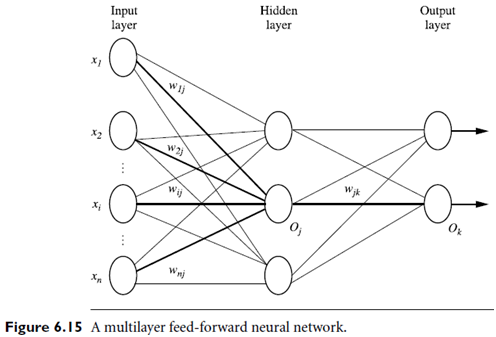SKEDSOFT
Introduction: The back propagation algorithm performs learning on a multilayer feed-forward neural network. It iteratively learns a set of weights for prediction of the class label of tuples. A multilayer feed-forward neural network consists of an input layer, one or more hidden layers, and an output layer.
An example of a multilayer feed-forward network is shown in Figure 6.15.
Each layer is made up of units. The inputs to the network correspond to the attributes measured for each training tuple. The inputs are fed simultaneously into the units making up the input layer. These inputs pass through the input layer and are then weighted and fed simultaneously to a second layer of “neuron like” units, known as a hidden layer. The outputs of the hidden layer units can be input to another hidden layer, and so on. The number of hidden layers is arbitrary, although in practice, usually only one is used.
 The weighted outputs of the last hidden layer are input to units making up the output layer, which emits the network’s prediction for given tuples. The units in the input layer are called input units. The units in the hidden layers and output layer are sometimes referred to as neurodes, due to their symbolic biological basis, or as output units. The multilayer neural network shown in Figure 6.15 has two layers of output units. Therefore, we say that it is a two-layer neural network. (The input layer is not counted because it serves only to pass the input values to the next layer.) Similarly, a network containing two hidden layers is called a three-layer neural network, and so on.
The weighted outputs of the last hidden layer are input to units making up the output layer, which emits the network’s prediction for given tuples. The units in the input layer are called input units. The units in the hidden layers and output layer are sometimes referred to as neurodes, due to their symbolic biological basis, or as output units. The multilayer neural network shown in Figure 6.15 has two layers of output units. Therefore, we say that it is a two-layer neural network. (The input layer is not counted because it serves only to pass the input values to the next layer.) Similarly, a network containing two hidden layers is called a three-layer neural network, and so on.
The network is feed-forward in that none of the weights cycles back to an input unit or to an output unit of a previous layer. It is fully connected in that each unit provides input to each unit in the next forward layer.
Each output unit takes, as input, a weighted sum of the outputs from units in the previous layer . It applies a nonlinear (activation) function to the weighted input. Multilayer feed-forward neural networks are able to model the class prediction as a nonlinear combination of the inputs. From a statistical point of view, they perform nonlinear regression. Multilayer feed-forward networks, given enough hidden units and enough training samples, can closely approximate any function.